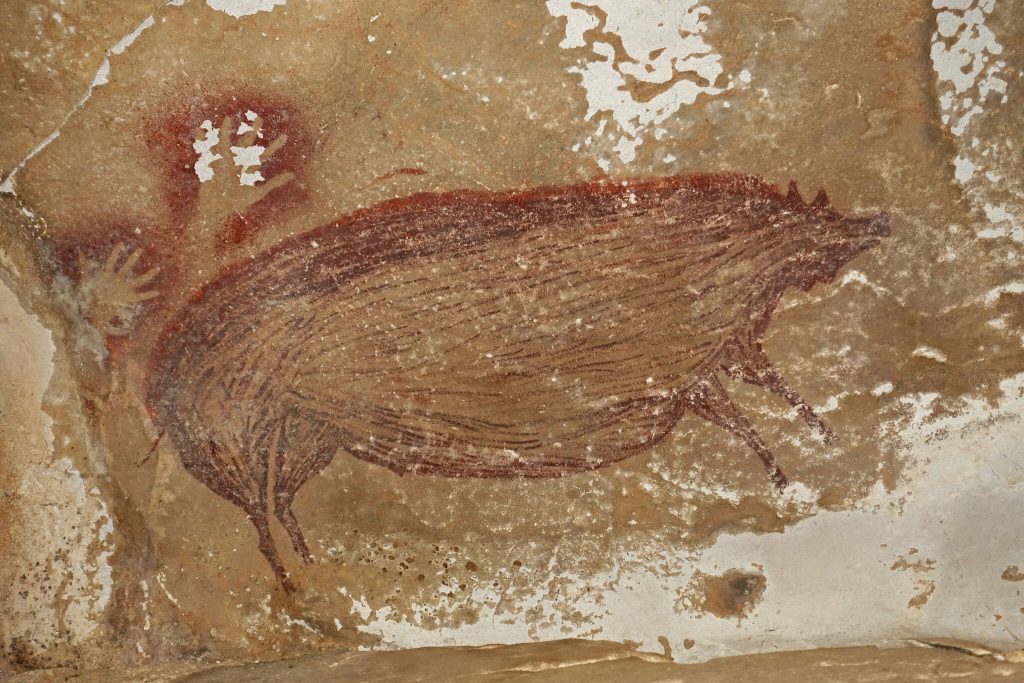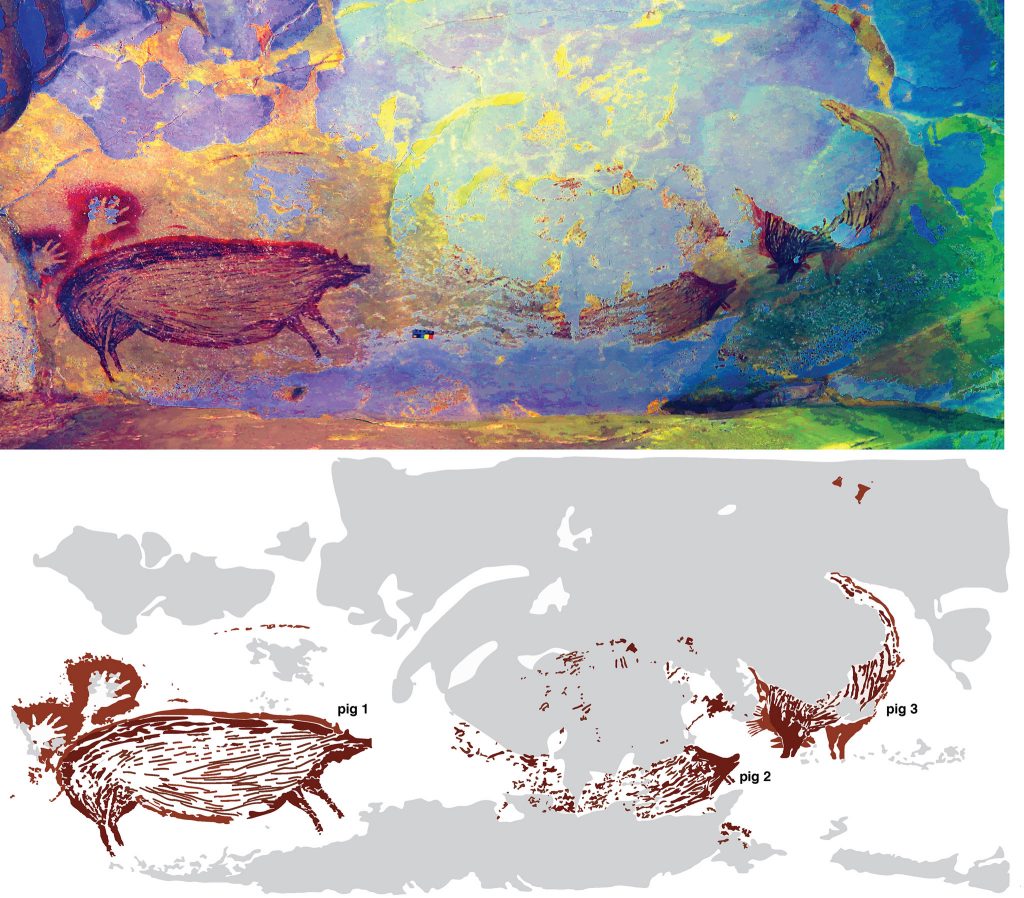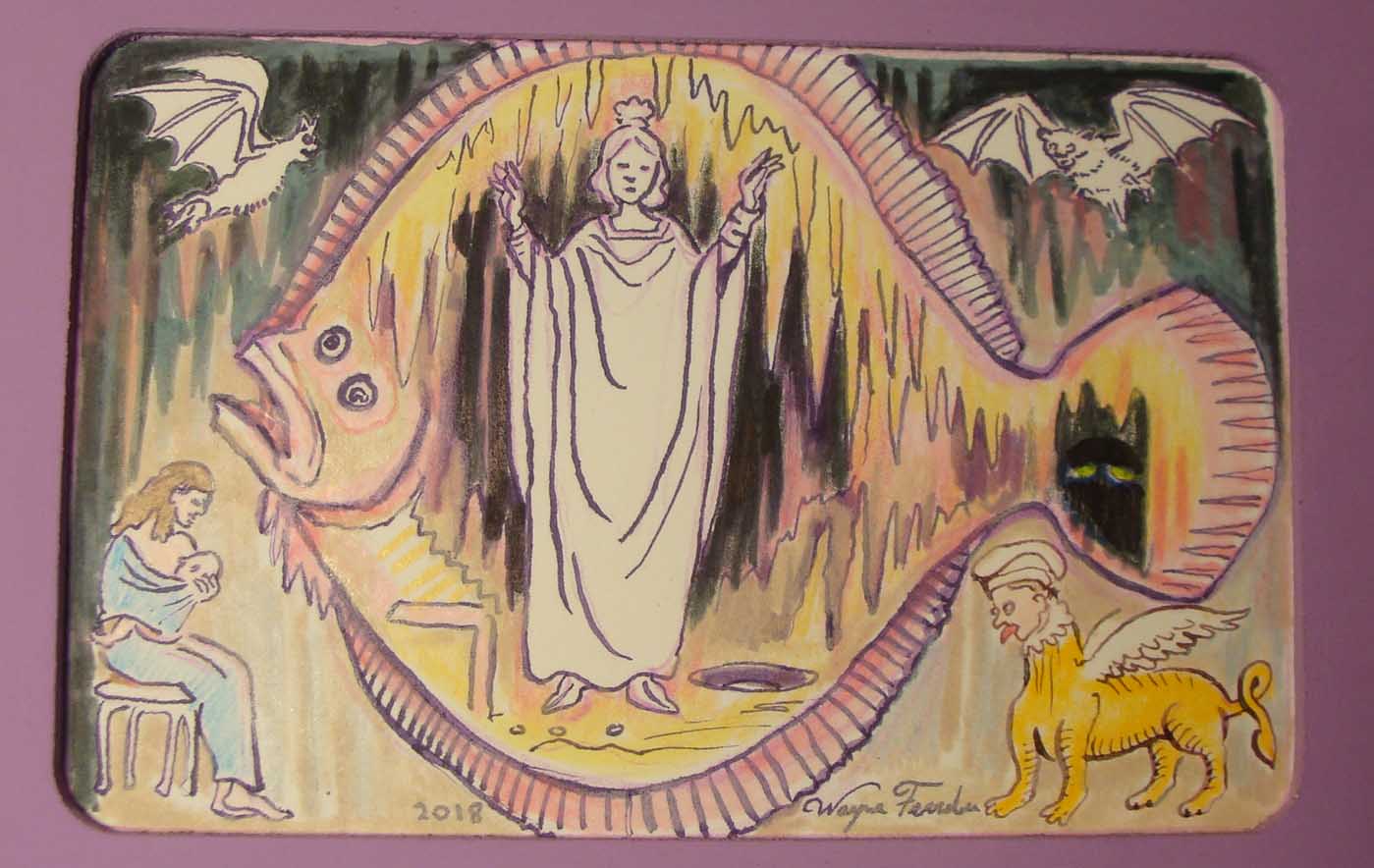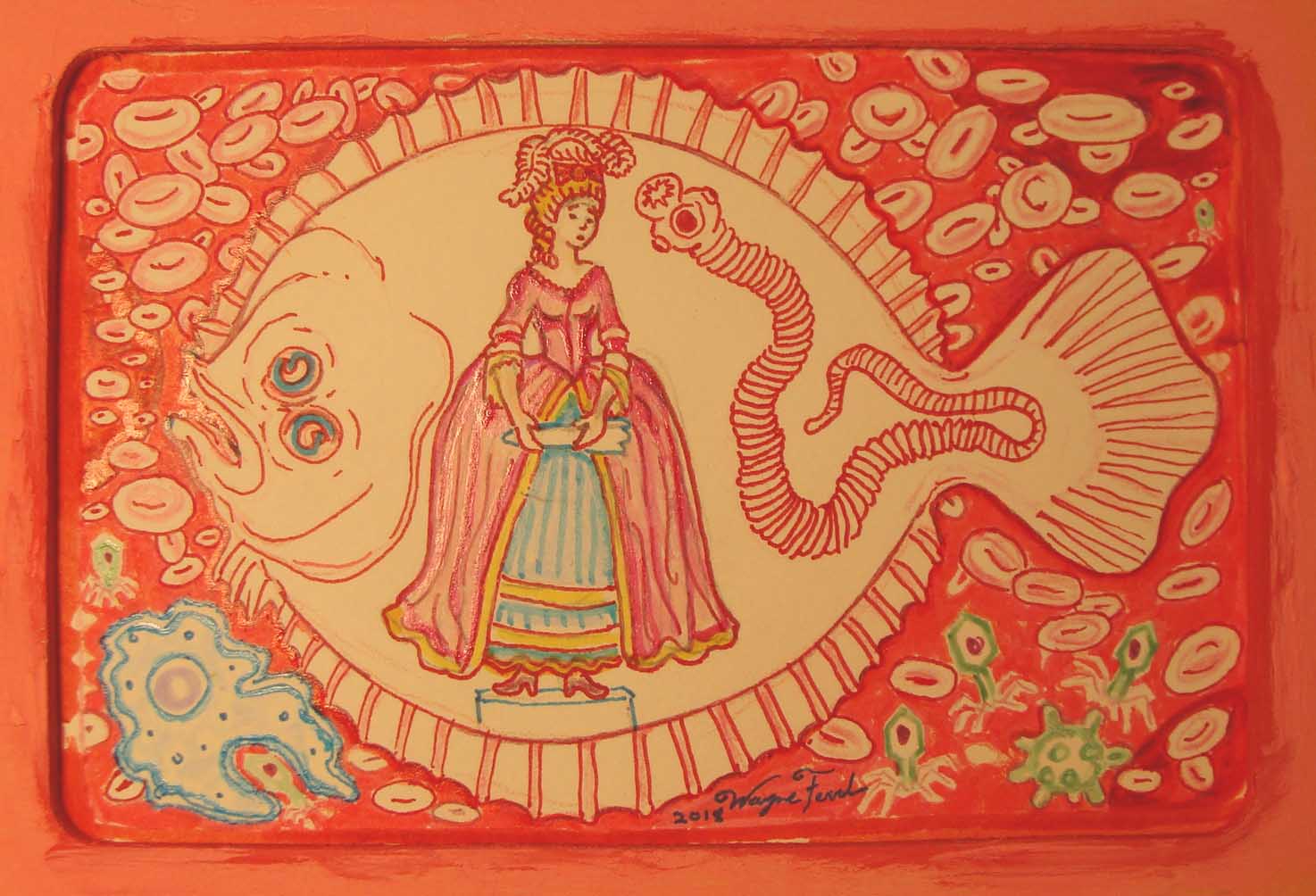You are currently browsing the tag archive for the ‘cave’ tag.

This may be the world’s oldest known representational artwork– a red ochre painting of a warty pig recently discovered in the Leang Tedongnge cave of Sulawesi, Indonesia. The full work is actually three pigs–two pigs fighting (?) while one pig watches from a distance, but the fighting pigs have been effaced by scores of millennia, whereas the bystander pig has somehow avoided the elements as well as the fray.

Archaeologists believe the painting is 45,000 years old, an extraordinary age in dealing with human artifacts. They arrived at that number by means of measuring the decay of infinitesimal amounts of uranium in mineral deposits formed on top of the image (this methodology is not without drawbacks and controversies, but remains the go-to mechanism of dating for 45,000 year old non-carboniferous artworks). Sulawesi is the world’s eleventh largest island. Because it is located at the nexus of three small and two giant tectonic plates it resembles a squashed asterisk. Homo Erectus found a home in Indonesia as early as 2 million years ago, but Homo Sapiens reached the island, around the time this painting was made, 45,000 years ago. Modern Austronesian people (who make up the majority of Indonesia’s living population) only arrived 2000 years ago.

The pig portrayed here is interesting as well! It is a Celebes Warty pig (Sus celebensis), a medium sized pig which was originally native solely to Sulawesi. The warty pig is the only pig species to be domesticated other than Sus scrofa, the Eurasian wild pig, which probably makes up 99 percent (or more) or the world pig population. Clearly such pigs were of enormous importance to the first homo sapiens of Indonesia–a nearby cave painting from 43.900 years ago (previously the world’s oldest known representative artwork) shows spear-wielding humans approaching pigs and small buffalo. Yet, as with all art, the full reasons behind the creation of the work remain elusive. What is certain is that it is rather good! In addition to an expressive sense of lively movement, the pig has true character and personality. Just look at its hungry face!


Regular visitors know that my alter-ego/spirit animal is the flounder (or, at any rate, the flatfish is definitely the leitmotif of this period of my ecology/history themed art). During lunchbreak or on the train I work on little “lesser” flounder drawings. In the near future I plan to put them all on a little internet store…along with some of the prints of the intricate flounder I have been drawing. Also there will be an interactive online flounder…it will all be the glorious artistic unveiling I have been hinting at for a while. You are going to love it!…erm…hopefully. In the mean time though, here are three of the most recent small flounder drawings I do during my busy Midtown days to keep from going crazy. The one at the top is some sort or oracle emerging from the underworld depths of the flounder itself. I don’t know what secrets this augur has…or even what gender they are, but they have brought unfathomable mysteries to light from the cave depths. A vile chef-beast lurks to the right roaring of appetites which can never be sated, while, at left a young mother nurses an infant: the next generation arises to take a place within the great weal, yet always there is appetite.

Speaking of which, this second flounder is meant to evoke the ifrits which always pop out of of ancient middle eastern oil lamps. A mysterious world of gauzy spirits, mystery beasts, and apparitions swirl around the lit lamp, but whether any of these blue spirits offer helpful advice or magical munificence is unclear.

Finally, I made a flounder which represents the bloodstream (my very first readers will recall that I had a childhood epiphany about the nature of living things based on blood). The cells stream forth to build the organism and carry out needed maintenance, but strange viruses swirl within the plasma. most ominously a parasitic tapeworm stares in hunger at the feast of little lives. It is unclear whether the aristocratic woman is a parasite or whether she is the host. This is a whole little ecosystem with the long-suffering flounder in the middle.
I will add all of these flounder to my Instagram feed (which you should follow), but you can see them here first, and read the perplexing explanations I have offered.

Here is one of the world’s rarest and strangest fish, the golden cave catfish (Clarias cavernicola) which can be found only one place on Earth, the Algamas/Dragonsbreath cave in the Namib Desert. This incredible cavern is 100 meters (300 feet) beneath the desert and it holds the world’s largest known underground lake (discounting all subglacial lakes—which can be huge). Above ground is an arid desert wasteland, but in cave is a huge lake where unfathomed waters may descend another 100 meters into the Earth. Since only a narrow chasm opens to the sky, the lake has a very limited ecosystem built around whatever falls into this chasm (which was only discovered by science in 1986). These blind ascetic catfish dwell on such scraps and on the white shrimp and strange aquatic worms which live in the water beneath the desert. Though they have lost their eyes, their other senses have become extremely acute in order to find every bug or speck of nutrient which falls into the hidden lake. Additionally, these small (16 cm/6 inch) fish have a limited ability to sip air–so that they can better survive the still and anaerobic depths of their hidden lake. The entire species may only consist of a few hundred (or thousand) individuals.

 One of the most enigmatic Greek divinities is Nyx, the primordial goddess of the Night. In Hesiod’s Theogeny she was a child of Chaos, but, in other texts, Nyx was present at (or before) creation and had no parents. She is rarely mentioned in classical texts, but the few times she does appear are noteworthy. Some of her children include Death (Thanatos), Sleep (Hypnos), Mockery (Momus), Dreams (Morpheus), and the Fates (Moirae)–they represent various slantwise forces which even the Olympian gods are subject to.
One of the most enigmatic Greek divinities is Nyx, the primordial goddess of the Night. In Hesiod’s Theogeny she was a child of Chaos, but, in other texts, Nyx was present at (or before) creation and had no parents. She is rarely mentioned in classical texts, but the few times she does appear are noteworthy. Some of her children include Death (Thanatos), Sleep (Hypnos), Mockery (Momus), Dreams (Morpheus), and the Fates (Moirae)–they represent various slantwise forces which even the Olympian gods are subject to.
Nyx is mentioned in Chapter XIV of Homer’s Illiad, when the sleep god Hypnos refuses to carry out Hera’s bidding. Hypnos describes the past results of putting Zeus to sleep (against Zeus’ will) and relates how his mother saved him:
“Jove was furious when he awoke, and began hurling the gods about all over the house; he was looking more particularly for myself, and would have flung me down through space into the sea where I should never have been heard of any more, had not Night who cows both men and gods protected me. I fled to her and Jove left off looking for me in spite of his being so angry, for he did not dare do anything to displease Night. And now you are again asking me to do something on which I cannot venture.” [Forgive the Roman names—I used the Johnson translation for ease of citation and copying. Also, obviously, Nyx is called “Night” as she is in the rough Aristophanes quote below. I’ll try to find some prettier translations later.]
Nyx is also mentioned in Orphic cult poetry (certain mystery cult poems were attributed to the demigod Orpheus) where she is portrayed as a bird/woman with black wings who first created the universe. She dwells in a cave at the edge of the Cosmos. With her in the eternal darkness is Kronos, Zeus’ father, who was savagely mutilated by his son. Kronos is unconscious, drunk on magical honey, and he mutters prophecies which Nix then chants. Outside the cave is Zeus’ nursemaid, Adrasteia, who acted as mother for the king of the gods during his boyhood. Adrasteia keens and beats a cymbal to Nyx’s chanting and the entire universe subtly moves to the rhythm of her cymbal.
Aristophanes alludes to the Orphic mystery poetry in a chorus from his play “The Birds”. The chorus is sung by birds who have a different take on creation. In their interpretation, night is a bird and they are descended from her via love and chaos. Here is the relevant portion of their song:
…At the start,
was Chaos, and Night, and pitch-black Erebus,
and spacious Tartarus. There was no earth, no heaven,
no atmosphere. Then in the wide womb of Erebus,
that boundless space, black-winged Night, first creature born,
made pregnant by the wind, once laid an egg. It hatched,
when seasons came around, and out of it sprang Love—
the source of all desire, on his back the glitter
of his golden wings, just like the swirling whirlwind.
In broad Tartarus, Love had sex with murky Chaos.
From them our race was born—our first glimpse of the light
not before Love mixed all things up. But once they’d bred
and blended in with one another, Heaven was born,
Ocean and Earth—and all that clan of deathless gods.
Thus, we’re by far the oldest of all blessed ones,
for we are born from Love. There’s lots of proof for this.
We fly around the place, assisting those in love—
[Translation by Ian Johnston]
Although a few small temples and cults to Nyx existed, she was not often worshiped openly in Greece (nor, for that matter, were her children). However Nyx was in the background of many other god’s temples and ceremonies as a statue or a sacred phrase. Around her name and mythos was an impalpable shroud of ambiguity. To the Greeks, Nyx was older and stranger than the gods they cared about and worshiped–she was the first and original outsider.

